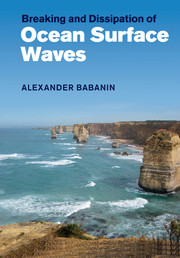3654 results in ebooks in fluid mechanics
Contents
-
- Book:
- Colloidal Suspension Rheology
- Published online:
- 05 December 2011
- Print publication:
- 17 November 2011, pp vii-xii
-
- Chapter
- Export citation
7 - Thixotropy
-
- Book:
- Colloidal Suspension Rheology
- Published online:
- 05 December 2011
- Print publication:
- 17 November 2011, pp 228-251
-
- Chapter
- Export citation
1 - Introduction to colloid science and rheology
-
- Book:
- Colloidal Suspension Rheology
- Published online:
- 05 December 2011
- Print publication:
- 17 November 2011, pp 1-35
-
- Chapter
- Export citation
Frontmatter
-
- Book:
- Colloidal Suspension Rheology
- Published online:
- 05 December 2011
- Print publication:
- 17 November 2011, pp i-vi
-
- Chapter
- Export citation
Index
-
- Book:
- Colloidal Suspension Rheology
- Published online:
- 05 December 2011
- Print publication:
- 17 November 2011, pp 388-393
-
- Chapter
- Export citation

Breaking and Dissipation of Ocean Surface Waves
-
- Published online:
- 25 October 2011
- Print publication:
- 19 May 2011
7 - Simplified schemes
-
- Book:
- Modelling Turbulence in Engineering and the Environment
- Published online:
- 05 November 2012
- Print publication:
- 20 October 2011, pp 240-312
-
- Chapter
- Export citation
8 - Wall functions
-
- Book:
- Modelling Turbulence in Engineering and the Environment
- Published online:
- 05 November 2012
- Print publication:
- 20 October 2011, pp 313-347
-
- Chapter
- Export citation
References
-
- Book:
- Modelling Turbulence in Engineering and the Environment
- Published online:
- 05 November 2012
- Print publication:
- 20 October 2011, pp 348-372
-
- Chapter
- Export citation
5 - Modelling the scale-determining equations
-
- Book:
- Modelling Turbulence in Engineering and the Environment
- Published online:
- 05 November 2012
- Print publication:
- 20 October 2011, pp 143-169
-
- Chapter
- Export citation
Nomenclature
-
- Book:
- Modelling Turbulence in Engineering and the Environment
- Published online:
- 05 November 2012
- Print publication:
- 20 October 2011, pp xii-xxii
-
- Chapter
- Export citation
1 - Introduction
-
- Book:
- Modelling Turbulence in Engineering and the Environment
- Published online:
- 05 November 2012
- Print publication:
- 20 October 2011, pp 1-12
-
- Chapter
- Export citation
4 - Approaches to closure
-
- Book:
- Modelling Turbulence in Engineering and the Environment
- Published online:
- 05 November 2012
- Print publication:
- 20 October 2011, pp 60-142
-
- Chapter
- Export citation
Chapter 6 - Modelling in the immediate wall vicinity and at low Ret
-
- Book:
- Modelling Turbulence in Engineering and the Environment
- Published online:
- 05 November 2012
- Print publication:
- 20 October 2011, pp 170-239
-
- Chapter
- Export citation
3 - Characterization of stress and flux dynamics: elements required for modelling
-
- Book:
- Modelling Turbulence in Engineering and the Environment
- Published online:
- 05 November 2012
- Print publication:
- 20 October 2011, pp 33-59
-
- Chapter
- Export citation
2 - The exact equations
-
- Book:
- Modelling Turbulence in Engineering and the Environment
- Published online:
- 05 November 2012
- Print publication:
- 20 October 2011, pp 13-32
-
- Chapter
- Export citation
Contents
-
- Book:
- Modelling Turbulence in Engineering and the Environment
- Published online:
- 05 November 2012
- Print publication:
- 20 October 2011, pp v-vi
-
- Chapter
- Export citation
Index
-
- Book:
- Modelling Turbulence in Engineering and the Environment
- Published online:
- 05 November 2012
- Print publication:
- 20 October 2011, pp 373-379
-
- Chapter
- Export citation
Preface
-
- Book:
- Modelling Turbulence in Engineering and the Environment
- Published online:
- 05 November 2012
- Print publication:
- 20 October 2011, pp vii-xi
-
- Chapter
- Export citation
Frontmatter
-
- Book:
- Modelling Turbulence in Engineering and the Environment
- Published online:
- 05 November 2012
- Print publication:
- 20 October 2011, pp i-iv
-
- Chapter
- Export citation
